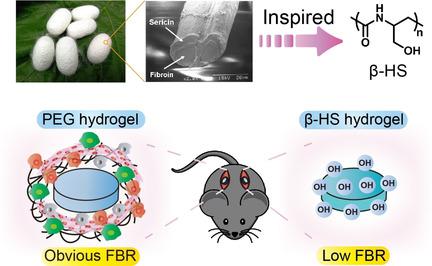当前位置:
X-MOL 学术
›
Angew. Chem. Int. Ed.
›
论文详情
Our official English website, www.x-mol.net, welcomes your
feedback! (Note: you will need to create a separate account there.)
Silk-Inspired β-Peptide Materials Resist Fouling and the Foreign-Body Response.
Angewandte Chemie International Edition ( IF 16.1 ) Pub Date : 2020-03-13 , DOI: 10.1002/anie.202000416 Donghui Zhang 1 , Qi Chen 1 , Wenjing Zhang 2 , Hengjiang Liu 3 , Jianglin Wan 1 , Yuxin Qian 2 , Bing Li 2 , Songchao Tang 2 , Yu Liu 3 , Shengfu Chen 4 , Runhui Liu 1, 2
Angewandte Chemie International Edition ( IF 16.1 ) Pub Date : 2020-03-13 , DOI: 10.1002/anie.202000416 Donghui Zhang 1 , Qi Chen 1 , Wenjing Zhang 2 , Hengjiang Liu 3 , Jianglin Wan 1 , Yuxin Qian 2 , Bing Li 2 , Songchao Tang 2 , Yu Liu 3 , Shengfu Chen 4 , Runhui Liu 1, 2
Affiliation

|
The functions of implants like medical devices are often compromised by the host's foreign‐body response (FBR). Herein, we report the development of low‐FBR materials inspired by serine‐rich sericin from silk. Poly‐β‐homoserine (β‐HS) materials consist of the hydrophilic unnatural amino acid β‐homoserine. Self‐assembled monolayers (SAMs) of β‐HS resist adsorption by diverse proteins, as well as adhesion by cells, platelets, and diverse microbes. Experiments lasting up to 3 months revealed that, while implantation with control PEG hydrogels induced obvious inflammatory responses, collagen encapsulation, and macrophage accumulation, these responses were minimal with β‐HS hydrogels. Strikingly, the β‐HS hydrogels induce angiogenesis in implant‐adjacent tissues. Molecular dynamics simulations indicated that the low FBR performance of β‐HS results from what we term “dual hydrogen bonding hydration”, wherein both the backbone amide groups and the sidechain hydroxyl groups of β‐HS undergo hydration.
中文翻译:

受丝绸启发的β肽材料可防止结垢和异物响应。
宿主的异物反应(FBR)通常会损害医疗设备等植入物的功能。本文中,我们报告了低FBR材料的发展,其灵感来自丝绸中富含丝氨酸的丝胶。聚β-高丝氨酸(β-HS)材料由亲水性非天然氨基酸β-高丝氨酸组成。β-HS的自组装单分子层(SAMs)可以抵抗多种蛋白质的吸附,以及细胞,血小板和多种微生物的粘附。历时3个月的实验表明,尽管植入对照PEG水凝胶可引起明显的炎症反应,胶原蛋白包封和巨噬细胞蓄积,但使用β-HS水凝胶的反应却极少。令人惊讶的是,β-HS水凝胶可在植入物附近的组织中诱导血管生成。
更新日期:2020-03-13
中文翻译:

受丝绸启发的β肽材料可防止结垢和异物响应。
宿主的异物反应(FBR)通常会损害医疗设备等植入物的功能。本文中,我们报告了低FBR材料的发展,其灵感来自丝绸中富含丝氨酸的丝胶。聚β-高丝氨酸(β-HS)材料由亲水性非天然氨基酸β-高丝氨酸组成。β-HS的自组装单分子层(SAMs)可以抵抗多种蛋白质的吸附,以及细胞,血小板和多种微生物的粘附。历时3个月的实验表明,尽管植入对照PEG水凝胶可引起明显的炎症反应,胶原蛋白包封和巨噬细胞蓄积,但使用β-HS水凝胶的反应却极少。令人惊讶的是,β-HS水凝胶可在植入物附近的组织中诱导血管生成。











































 京公网安备 11010802027423号
京公网安备 11010802027423号